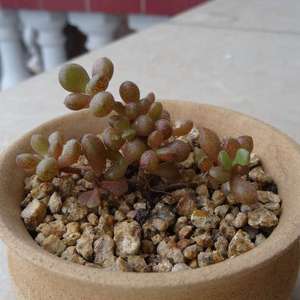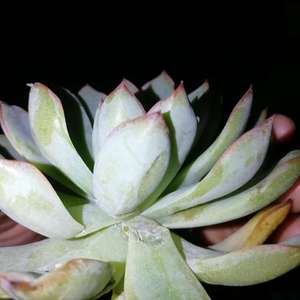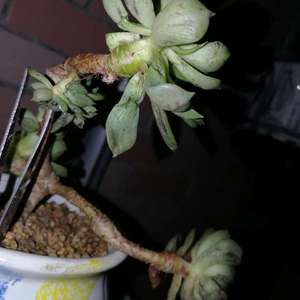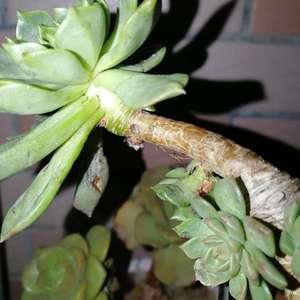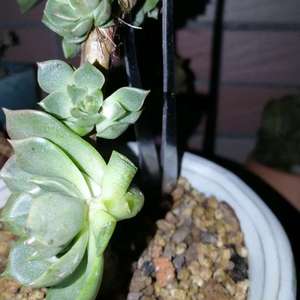求助
jordi
2018年07月26日

ID Help Please !! I have this plant and have had it for 2-3 years. The third pic is the plant as a baby. This big boy got so tall and is now over 1 and a half feet (not even straightened, I measured it while it was in its natural position) It was about 6 inches when I first got it. Some sticks are in the soil to help hold the limbs up, they are not part of the plant. Thanks !

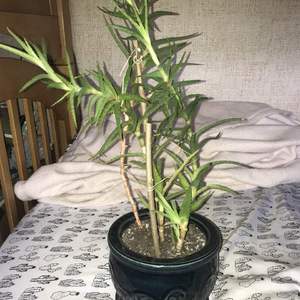
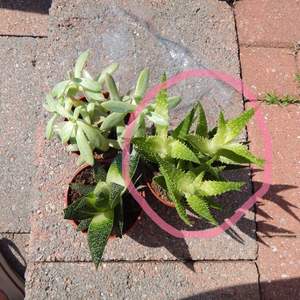
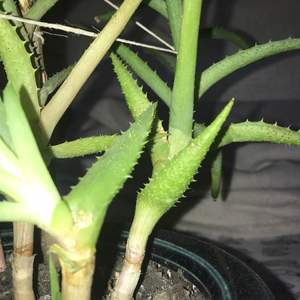




0
0
初心~:你这个长成了恨天高
jordi:@Shanee I think it wouldn’t be a candelabra since I’ve had it for a long time and it hasn’t flowered. It is gooey inside so it’s possible though. Thanks so much !
Shanee:Possible candelabra aloe. Or aloe Vera that’s needing more light.
文章
Miss Chen
2018年07月26日

Description: This herbaceous perennial plant is 1½–3' tall and little branched. The central stem is light green to reddish brown, glabrous to slightly hairy, and terete or angular. The alternate leaves are up to 5" long, 2" across, and variable in shape; the lowest leaves are often cordate-oval, while the middle and upper leaves are ovate-lanceolate to lanceolate. All of these leaves have crenate or serrated margins; their upper surfaces are medium to dark green, while their lower surfaces are light green and short-hairy along the veins. The lower and middle leaves have slender petioles, while the upper leaves are more likely to be sessile. Sometimes short leafy stalks develop from the axils of the leaves on the central stem.
The central stem terminates in an elongated raceme of flowers up to 1' long. The flowers tend to nod downward along one side of the raceme on short pedicels. At the base of each pedicel, there is a small leafy bract that is linear-lanceolate in shape. Sometimes nodding flowers are produced from the axils of the upper leaves on longer pedicels. Each flower has a bell-shaped blue-violet corolla, 5 green sepals, 5 stamens, and an exerted style with 3 curled stigmas. The corolla is 1–1½" long and half as much across; it has 5 pointed lobes that are recurved. The sepals are linear-lanceolate in shape, widely spreading to recurved, and much smaller in size than the corolla. The style is white or pale purple. The blooming period occurs from mid-summer to early fall and lasts about a month. Each flower is replaced by a globoid seed capsule that contains several small seeds. The root system is rhizomatous. Occasionally, small colonies of plants are produced from the long rhizomes.
Cultivation: The preference is full to partial sun, more or less mesic conditions, and a fertile loamy soil.

Range & Habitat: Creeping Bellflower naturalizes occasionally in northern Illinois and uncommonly in central Illinois; it is apparently rare or absent in southern Illinois (see Distribution Map). This species was introduced into North America from Europe as an ornamental plant. Habitats include open woodlands, savannas, thickets, fence rows, edges of yards, roadsides, and waste areas. Creeping Bellflower is often cultivated in gardens because of its showy flowers.
Faunal Associations: According to Müller (1873/1883), the flowers of Creeping Bellflower produce both nectar and pollen. Müller observed honeybees, bumblebees, Halictid bees, and other bees visiting the flowers for nectar or pollen in Germany; he also observed a Syrphid fly with a long proboscis (Rhingia sp.) sucking nectar from the flowers. Aside from these observations, further information about floral-faunal relationships for this species are unavailable.

Photographic Location: The photographs were taken at a flower garden in Urbana, Illinois.
Comments: Creeping Bellflower has very showy flowers. Among the Eurasian bellflowers that are cultivated, this is the species that most often escapes — in part because it is more commonly cultivated. A species that has naturalized less often in Illinois, Campanula glomerata (Clustered Bellflower), has more erect flowers that are clustered together at the apex each central stem. The flowers of this species have sepals that are longer and wider than those of Creeping Bellflower. The circumboreal Campanula rotundifolia (Harebells) and native Campanulastrum americanum (American Bellflower) are quite distinct from Creeping Bellflower. Harebells has linear leaves along its stems and its bell-shaped flowers are smaller in size (usually less than 1" in length) than those of creeping Bellflower. The flowers of American Bellflower have shallow corollas that are star-shaped with widely spreading lobes; the older scientific name of this latter species is Campanula americana.
The central stem terminates in an elongated raceme of flowers up to 1' long. The flowers tend to nod downward along one side of the raceme on short pedicels. At the base of each pedicel, there is a small leafy bract that is linear-lanceolate in shape. Sometimes nodding flowers are produced from the axils of the upper leaves on longer pedicels. Each flower has a bell-shaped blue-violet corolla, 5 green sepals, 5 stamens, and an exerted style with 3 curled stigmas. The corolla is 1–1½" long and half as much across; it has 5 pointed lobes that are recurved. The sepals are linear-lanceolate in shape, widely spreading to recurved, and much smaller in size than the corolla. The style is white or pale purple. The blooming period occurs from mid-summer to early fall and lasts about a month. Each flower is replaced by a globoid seed capsule that contains several small seeds. The root system is rhizomatous. Occasionally, small colonies of plants are produced from the long rhizomes.
Cultivation: The preference is full to partial sun, more or less mesic conditions, and a fertile loamy soil.

Range & Habitat: Creeping Bellflower naturalizes occasionally in northern Illinois and uncommonly in central Illinois; it is apparently rare or absent in southern Illinois (see Distribution Map). This species was introduced into North America from Europe as an ornamental plant. Habitats include open woodlands, savannas, thickets, fence rows, edges of yards, roadsides, and waste areas. Creeping Bellflower is often cultivated in gardens because of its showy flowers.
Faunal Associations: According to Müller (1873/1883), the flowers of Creeping Bellflower produce both nectar and pollen. Müller observed honeybees, bumblebees, Halictid bees, and other bees visiting the flowers for nectar or pollen in Germany; he also observed a Syrphid fly with a long proboscis (Rhingia sp.) sucking nectar from the flowers. Aside from these observations, further information about floral-faunal relationships for this species are unavailable.

Photographic Location: The photographs were taken at a flower garden in Urbana, Illinois.
Comments: Creeping Bellflower has very showy flowers. Among the Eurasian bellflowers that are cultivated, this is the species that most often escapes — in part because it is more commonly cultivated. A species that has naturalized less often in Illinois, Campanula glomerata (Clustered Bellflower), has more erect flowers that are clustered together at the apex each central stem. The flowers of this species have sepals that are longer and wider than those of Creeping Bellflower. The circumboreal Campanula rotundifolia (Harebells) and native Campanulastrum americanum (American Bellflower) are quite distinct from Creeping Bellflower. Harebells has linear leaves along its stems and its bell-shaped flowers are smaller in size (usually less than 1" in length) than those of creeping Bellflower. The flowers of American Bellflower have shallow corollas that are star-shaped with widely spreading lobes; the older scientific name of this latter species is Campanula americana.
0
0
文章
Miss Chen
2018年07月26日

Description: This plant is a winter annual or biennial that becomes ½–2' tall, branching very little except at the base. The round stems are more or less hairy. The alternate leaves are up to 1½" long and ¼" across. They are oblanceolate, lanceolate-oblong, or oblong-linear, and sessile at the base. The upper surface of each leaf has a single central vein, but radiating side veins are not visible. The leaves are more or less pubescent, although they occasionally have longer white hairs. Their margins are smooth and ciliate.
The nearly sessile flowers develop from the axils of the leaves in the upper portion of the stems. They are bunched together while in bloom or at the bud stage, but become more separated from each other as the flowering stems continue to elongate. Each flower is about ¼" long, consisting of a tubular white corolla with 5 small lobes and a hairy green calyx with 5 teeth that are linear-lanceolate. These teeth are about as long as the corolla. There are 5 stamens and a pistil that are inserted within the narrow throat of the corolla. The blooming period can occur from mid-spring to mid-summer and lasts about 2 months. Each flower is replaced by 4 nutlets. A nutlet is truncate at the base and tapers to a blunt round tip at the top. It is broadest a little below the middle, and has a greyish brown surface that is rough and wrinkled. The root system consists of a taproot. This plant spreads by reseeding itself.
Cultivation: This adaptable plant can be found in full or partial sun and mesic conditions in fertile loam, clay-loam, or sandy soil. Open areas are preferred where there is a scarcity of taller plants.
Close-up of FlowersRange & Habitat: Corn Gromwell is occasional to locally common in most areas of Illinois, except in the NW and SE, where it is uncommon or absent (see Distribution Map). It is adventive in North America and native to Eurasia. Habitats include cropland consisting of winter wheat or rye, fallow fields, vacant lots, grassy areas along roadsides and railroads, and miscellaneous waste areas. This weed occurs primarily in fields or along railroads, but it also appears in run-down areas of cities. Corn Gromwell prefers disturbed areas, and doesn't invade high quality natural sites to any significant degree.

Faunal Associations: Little information is available about floral-faunal relations for this species. According to Muller of 19th century Germany, the flowers of Corn Gromwell have few insect visitors. Occasionally, they attracted White butterflies, bees, and Syrphid flies.
Photographic Location: A grassy vacant lot in Urbana, Illinois.
Comments: This is a rather inconspicuous plant even while it is blooming. Corn Gromwell resembles many other weeds with small white flowers, but it has a distinguishing characteristic that sets it apart: The teeth of the hairy calyx are unusually long, slender, and conspicuous – about the same length as the flowers. Long after the corolla of a flower has withered away, the teeth of the calyx surround the nutlets on all sides and are much taller than them. Corn Gromwell resembles other members of the Borage family to some extent, including the native Lithospermum latifolium (American Gromwell) and introduced Lithospermum officinale (European Gromwell). However, these latter species have wider leaves with conspicuous side veins. Corn Gromwell is easily distinguished from the many weedy members of the Mustard family because its tubular flowers have 5 petal-like lobes, while the flowers of the latter have only 4 petals. An obsolete scientific name for this plant is Lithospermum arvense.
The nearly sessile flowers develop from the axils of the leaves in the upper portion of the stems. They are bunched together while in bloom or at the bud stage, but become more separated from each other as the flowering stems continue to elongate. Each flower is about ¼" long, consisting of a tubular white corolla with 5 small lobes and a hairy green calyx with 5 teeth that are linear-lanceolate. These teeth are about as long as the corolla. There are 5 stamens and a pistil that are inserted within the narrow throat of the corolla. The blooming period can occur from mid-spring to mid-summer and lasts about 2 months. Each flower is replaced by 4 nutlets. A nutlet is truncate at the base and tapers to a blunt round tip at the top. It is broadest a little below the middle, and has a greyish brown surface that is rough and wrinkled. The root system consists of a taproot. This plant spreads by reseeding itself.
Cultivation: This adaptable plant can be found in full or partial sun and mesic conditions in fertile loam, clay-loam, or sandy soil. Open areas are preferred where there is a scarcity of taller plants.
Close-up of FlowersRange & Habitat: Corn Gromwell is occasional to locally common in most areas of Illinois, except in the NW and SE, where it is uncommon or absent (see Distribution Map). It is adventive in North America and native to Eurasia. Habitats include cropland consisting of winter wheat or rye, fallow fields, vacant lots, grassy areas along roadsides and railroads, and miscellaneous waste areas. This weed occurs primarily in fields or along railroads, but it also appears in run-down areas of cities. Corn Gromwell prefers disturbed areas, and doesn't invade high quality natural sites to any significant degree.

Faunal Associations: Little information is available about floral-faunal relations for this species. According to Muller of 19th century Germany, the flowers of Corn Gromwell have few insect visitors. Occasionally, they attracted White butterflies, bees, and Syrphid flies.
Photographic Location: A grassy vacant lot in Urbana, Illinois.
Comments: This is a rather inconspicuous plant even while it is blooming. Corn Gromwell resembles many other weeds with small white flowers, but it has a distinguishing characteristic that sets it apart: The teeth of the hairy calyx are unusually long, slender, and conspicuous – about the same length as the flowers. Long after the corolla of a flower has withered away, the teeth of the calyx surround the nutlets on all sides and are much taller than them. Corn Gromwell resembles other members of the Borage family to some extent, including the native Lithospermum latifolium (American Gromwell) and introduced Lithospermum officinale (European Gromwell). However, these latter species have wider leaves with conspicuous side veins. Corn Gromwell is easily distinguished from the many weedy members of the Mustard family because its tubular flowers have 5 petal-like lobes, while the flowers of the latter have only 4 petals. An obsolete scientific name for this plant is Lithospermum arvense.
0
0
文章
Miss Chen
2018年07月26日

Description: This plant is an annual or biennial about 1-3' tall. Small plants are branched sparingly, while large plants branch abundantly in the upper half. The stems are gray-green or gray-blue, terete, glabrous, and glaucous. Plants that begin growth during the fall will overwinter as low rosettes with basal leaves, while plants that begin growth during the spring bolt upward almost immediately. Both the basal and lower leaves are up to 10" long and 2" across, but they are usually smaller than this. They are oblanceolate in overall shape and strongly pinnatifid with undulate or bluntly dentate margins; their terminal lobes are the largest in size. Both types of leaves have stout petioles. In contrast, the middle to upper leaves are smaller in size, lanceolate-oblong in shape, with margins that are smooth or bluntly dentate. These latter leaves have bases that usually clasp their stems, although some of them may be sessile. Like the stems, these various leaves are grey-green or blue-green, glaucous, and usually glabrous – occasionally the basal leaves have short bristly hairs. The lower, middle, and upper leaves are alternate.
The upper stems terminate in racemes of bright yellow flowers. The flowers bloom toward the apex of each raceme, while the seedpods develop below. Each flower is 1/3–1/2" (8-12 mm.) across, consisting of 4 yellow petals, 4 green to yellow sepals, several stamens, and a pistil with a single style. The sepals are narrowly lanceolate and hairless. The blooming period can occur anytime between late spring to early fall; it usually lasts about 1 month for a small colony of plants. Each flower is replaced by an ascending cylindrical seedpod (silique) that is 1¼–2¼" long at maturity and hairless. Each seedpod terminates in a seedless beak that is about one-fourth its entire length. At the base of each seedpod, there is a stout hairless pedicel about ½" long that is widely spreading to ascending. Each seedpod divides into 2 valves to release its small globoid seeds. The root system consists of a taproot. This plant reproduces by reseeding itself.
Cultivation: Rape Mustard prefers full sunlight, moist to dry conditions, and a neutral to alkaline soil containing loam, clay-loam, or gravelly material. The size of individual plants varies greatly according to moisture conditions and soil fertility.
Range & Habitat: Rape Mustard is occasional in most areas of Illinois (see Distribution Map). It is native to Eurasia. Typical habitats include cropland, weedy fields, roadsides, gravelly areas along railroads, and waste areas. This plant is usually found in areas with a history of disturbance where there is scant ground vegetation.

Faunal Associations: The nectar of the flowers attracts small bees and White butterflies (Pieridae); some bees may collect pollen from the flowers as well. The caterpillars of the butterflies Pieris napi (Mustard White), Pieris rapae (Cabbage White), and Pontia protodice (Checkered White) feed on Brassica spp. (Mustards), as do the caterpillars of the moths Evergestis pallidata (Purple-Backed Cabbageworm) and Plutella xylostella (Diamondback Moth). Several species of flea beetles (primarily Phyllotreta spp.), Murgantia histrionica (Harlequin Bug), and Adelphocoris superbus (Meadow Plant Bug) also feed on the foliage of these plants. The oily seeds of Rape Mustard and similar species are eaten by the Mourning Dove and Ring-Necked Pheasant, and the mild-tasting foliage can be eaten in limited amounts by livestock and other mammalian herbivores.
Photographic Location: A gravelly area along a railroad in Savoy, Illinois.
Comments: This is another weedy mustard species from Eurasia. It should not be confused with the agricultural crop, Oilseed Rape (or Canola), which is Brassica napus oleifera, or one of the cultivated vegetables. Rape Mustard has several common names, including Field Mustard and Birdseed Rape. In general, Rape Mustard can be distinguished from other Brassica spp. (Mustards) by its glaucous gray-blue or gray-green foliage and its clasping alternate leaves. A similar species, Brassica oleracea (Wild Cabbage), shares these characteristics, but this latter species has larger flowers (exceeding ½" across) and it is quite rare in Illinois. Oilseed Rape has foliage that is more green than either Rape Mustard or Wild Cabbage, and its foliage isn't glaucous.
The upper stems terminate in racemes of bright yellow flowers. The flowers bloom toward the apex of each raceme, while the seedpods develop below. Each flower is 1/3–1/2" (8-12 mm.) across, consisting of 4 yellow petals, 4 green to yellow sepals, several stamens, and a pistil with a single style. The sepals are narrowly lanceolate and hairless. The blooming period can occur anytime between late spring to early fall; it usually lasts about 1 month for a small colony of plants. Each flower is replaced by an ascending cylindrical seedpod (silique) that is 1¼–2¼" long at maturity and hairless. Each seedpod terminates in a seedless beak that is about one-fourth its entire length. At the base of each seedpod, there is a stout hairless pedicel about ½" long that is widely spreading to ascending. Each seedpod divides into 2 valves to release its small globoid seeds. The root system consists of a taproot. This plant reproduces by reseeding itself.
Cultivation: Rape Mustard prefers full sunlight, moist to dry conditions, and a neutral to alkaline soil containing loam, clay-loam, or gravelly material. The size of individual plants varies greatly according to moisture conditions and soil fertility.
Range & Habitat: Rape Mustard is occasional in most areas of Illinois (see Distribution Map). It is native to Eurasia. Typical habitats include cropland, weedy fields, roadsides, gravelly areas along railroads, and waste areas. This plant is usually found in areas with a history of disturbance where there is scant ground vegetation.

Faunal Associations: The nectar of the flowers attracts small bees and White butterflies (Pieridae); some bees may collect pollen from the flowers as well. The caterpillars of the butterflies Pieris napi (Mustard White), Pieris rapae (Cabbage White), and Pontia protodice (Checkered White) feed on Brassica spp. (Mustards), as do the caterpillars of the moths Evergestis pallidata (Purple-Backed Cabbageworm) and Plutella xylostella (Diamondback Moth). Several species of flea beetles (primarily Phyllotreta spp.), Murgantia histrionica (Harlequin Bug), and Adelphocoris superbus (Meadow Plant Bug) also feed on the foliage of these plants. The oily seeds of Rape Mustard and similar species are eaten by the Mourning Dove and Ring-Necked Pheasant, and the mild-tasting foliage can be eaten in limited amounts by livestock and other mammalian herbivores.
Photographic Location: A gravelly area along a railroad in Savoy, Illinois.
Comments: This is another weedy mustard species from Eurasia. It should not be confused with the agricultural crop, Oilseed Rape (or Canola), which is Brassica napus oleifera, or one of the cultivated vegetables. Rape Mustard has several common names, including Field Mustard and Birdseed Rape. In general, Rape Mustard can be distinguished from other Brassica spp. (Mustards) by its glaucous gray-blue or gray-green foliage and its clasping alternate leaves. A similar species, Brassica oleracea (Wild Cabbage), shares these characteristics, but this latter species has larger flowers (exceeding ½" across) and it is quite rare in Illinois. Oilseed Rape has foliage that is more green than either Rape Mustard or Wild Cabbage, and its foliage isn't glaucous.
0
0
文章
Miss Chen
2018年07月25日

Description: This annual wildflower is 1½–2½' tall, branching occasionally. The stems are light to medium green, terete, hollow, and densely covered with stiff white hairs. Alternate leaves along these stems are 2-6" long and about one-third as much across; they are ovate, obovate, or oblanceolate in shape with margins that are smooth and slightly undulate. The upper leaf surface is dark green, wrinkled from indented veins, and covered with sparse appressed hairs. The lower leaf surface is light to medium green and hairy primarily along the undersides of the veins.
Upper stems terminate in scorpioid cymes of nodding flowers. Individual flowers are ¾-1" across, consisting of 5 lanceolate blue petals (rarely white or pink), 5 green sepals, 5 dark blue to black anthers that merge together to form a central beak, and an ovary with a single style. The linear sepals are covered with stiff white hairs along their outer surfaces; they are about the same length or a little shorter than the petals. Like the stems and sepals, the branches of each inflorescence are covered with stiff white hairs; they are green to dark red. In Illinois, the blooming period occurs from mid-summer into the fall, lasting about 1½-3 months. Each flower is replaced by 4 dark brown nutlets. The root system consists of a taproot. This wildflower spreads by reseeding itself.
Cultivation: The preference is a sunny position, mesic conditions, and a fertile loamy soil.
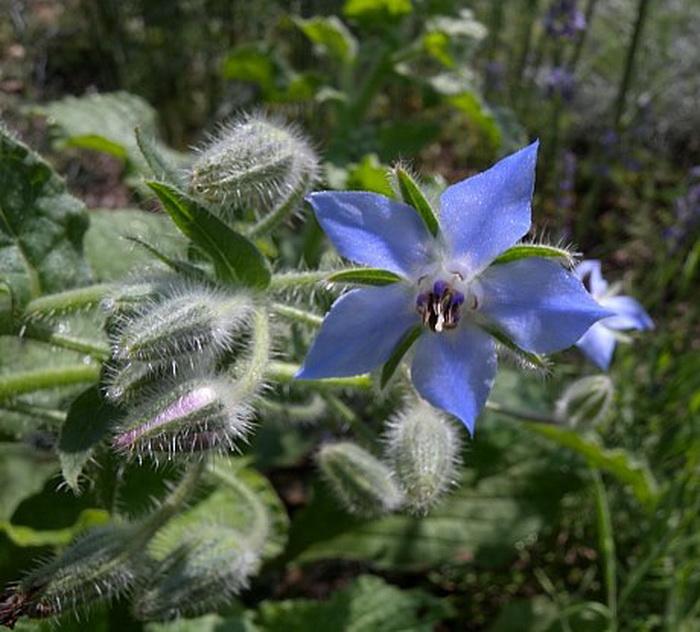
Range & Habitat: Borage has naturalized in only a few counties in Illinois (see Distribution Map). Naturalized populations rarely persist for more than a few years. Borage was introduced into North America from Europe as an herbal and ornamental plant; it is native to the Mediterranean area. Habitats consist of areas near buildings, rubbish heaps consisting of organic material, and waste areas. Borage is still cultivated in gardens.
Faunal Associations: According to Muëller (1873/1883), the nectar and pollen of the flowers attract bees, including honeybees, bumblebees, other long-tongued bees, and Halictid bees. It is unclear to what extent mammalian herbivores in North America feed on the foliage of Borage, which is mildly toxic from the presence of pyrrolizidine alkaloids. Similarly, there is lack of information about the consumption of seeds by birds and rodents.

Photographic Location: An herbal garden at Meadowbrook Park in Urbana, Illinois.
Comments: The most striking aspect of this plant are the star-shaped flowers; the petals have a shade of genuine blue that is uncommon among flowering plants. The flowers are reportedly edible with a sweet taste. The leaves are also eaten in salads and other dishes; they have a cucumber-like flavor. However, because of their potential toxicity, the leaves should be eaten in only small amounts. Because of its unique blue flowers, Borage is easy to identify. Other species in the Borage family have flowers with more conventional corollas.
Upper stems terminate in scorpioid cymes of nodding flowers. Individual flowers are ¾-1" across, consisting of 5 lanceolate blue petals (rarely white or pink), 5 green sepals, 5 dark blue to black anthers that merge together to form a central beak, and an ovary with a single style. The linear sepals are covered with stiff white hairs along their outer surfaces; they are about the same length or a little shorter than the petals. Like the stems and sepals, the branches of each inflorescence are covered with stiff white hairs; they are green to dark red. In Illinois, the blooming period occurs from mid-summer into the fall, lasting about 1½-3 months. Each flower is replaced by 4 dark brown nutlets. The root system consists of a taproot. This wildflower spreads by reseeding itself.
Cultivation: The preference is a sunny position, mesic conditions, and a fertile loamy soil.

Range & Habitat: Borage has naturalized in only a few counties in Illinois (see Distribution Map). Naturalized populations rarely persist for more than a few years. Borage was introduced into North America from Europe as an herbal and ornamental plant; it is native to the Mediterranean area. Habitats consist of areas near buildings, rubbish heaps consisting of organic material, and waste areas. Borage is still cultivated in gardens.
Faunal Associations: According to Muëller (1873/1883), the nectar and pollen of the flowers attract bees, including honeybees, bumblebees, other long-tongued bees, and Halictid bees. It is unclear to what extent mammalian herbivores in North America feed on the foliage of Borage, which is mildly toxic from the presence of pyrrolizidine alkaloids. Similarly, there is lack of information about the consumption of seeds by birds and rodents.

Photographic Location: An herbal garden at Meadowbrook Park in Urbana, Illinois.
Comments: The most striking aspect of this plant are the star-shaped flowers; the petals have a shade of genuine blue that is uncommon among flowering plants. The flowers are reportedly edible with a sweet taste. The leaves are also eaten in salads and other dishes; they have a cucumber-like flavor. However, because of their potential toxicity, the leaves should be eaten in only small amounts. Because of its unique blue flowers, Borage is easy to identify. Other species in the Borage family have flowers with more conventional corollas.
0
0
文章
Miss Chen
2018年07月25日

Description: This herbaceous biennial plant is 1–2½' tall. During the first year it forms a rosette of basal leaves up to 1' across, while during the second year it bolts upward with one or more flowering stalks. These stalks are hairless, stout, light green to reddish purple, and somewhat angular. Secondary stalks are produced in the upper half of the plant. The basal leaves are up to 6" long and 2½" across. They are odd-pinnate with 1-4 pairs of lateral lobes and a terminal lobe that is larger than the others. These lobes are oval, obovate, or nearly orbicular, and they have margins that are slightly undulate or bluntly dentate. The alternate leaves are sessile or clasp the stems. The lower to middle alternate leaves resemble the basal leaves, except that they are smaller and have fewer lateral lobes. The upper alternate leaves are up to 2" long and 1" across; their margins are shallowly lobed, undulate, or bluntly dentate. Both the basal and alternate leaves are dark green, hairless, and shiny on the upper surface.
The upper stems terminate in racemes of yellow flowers. The flowers bloom toward the apex of each raceme, while the seedpods (siliques) develop below. Each flower is up to 1/3" (8 mm.) across, consisting of 4 yellow petals, 4 yellowish green sepals that are linear-lanceolate, 6 stamens with pale yellow to light brown anthers, and a single pistil with a thick style. A robust plant will produce these flowers in great abundance and they are mildly fragrant. The blooming period occurs from mid-spring to early summer and lasts about 1 month (peaking during late spring). Each flower is replaced by an angular-cylindrical seedpod about ¾-1" long. The base of each seedpod is connected to a short slender pedicel, while at the other end it terminates in a short slender beak. These seedpods are ascending, rather than strictly erect, along the racemes. The seeds are ovoid, slightly flattened, and more or less brown. The root system consists of a stout taproot. This plant spreads by reseeding itself, and it occasionally forms colonies.

Cultivation: The preference is full sun, moist to mesic conditions, and a fertile loam or clay-loam soil. Growth is less robust at dry sites with poor soil. A little shade is also tolerated. Most vegetative growth occurs during the cool weather of early to mid-spring.
Range & Habitat: The adventive Yellow Rocket is a common plant that occurs in most counties of Illinois (see Distribution Map). It is native to Eurasia. Habitats include cropland, fallow fields, vacant lots, construction sites, gardens, moist meadows, areas along roadsides and railroads, and waste areas. Highly disturbed areas are preferred; sometimes this species occurs in natural areas that are slightly degraded (including prairie restorations), but it is not particularly invasive.

Faunal Associations: The nectar and pollen of the flowers attract Andrenid bees, other small bees, and flies primarily. Occasionally, the Cabbage White (Pieris rapae) and other White butterflies can be observed sucking nectar from the flowers. The caterpillars of some butterflies and moths feed on the foliage or flowers, including Pontia protodice (Checkered White), Pieris rapae (Cabbage White), Anthocharis midea (Falcate Orangetip), Eustixia pupula (Pyralid Moth sp.), and Evergestis pallidata (Purple-Backed Cabbageworm). Several leaf beetles feed on Yellow Rocket: Microtheca ochroloma, Phaedon viridis, Phyllotreta bipustulata, Phyllotreta conjuncta, Phyllotreta cruciferae, Phyllotreta striolata, Phyllotreta zimmermanni, Psylliodes convexior, and Psylliodes punctulatus. Another insect that feeds on this plant is the stinkbug Holcostethus limbolarius. The seeds are a minor source of food to the Mourning Dove, while the foliage is eaten by cattle and sheep.

Photographic Location: A vacant lot in Urbana, Illinois.
Comments: This plant is quite showy while it is in full bloom. The basal leaves are reportedly edible during the early spring, but they later become bitter. The Yellow Rocket that commonly occurs in Illinois is Barbarea vulgaris arcuata. The typical variety of Yellow Rocket is rarely seen in Illinois; it differs from var. arcuata by having erect seedpods (siliques). A species with a similar appearance, Barbarea verna (Early Winter Cress), occurs further to the east and is rarely observed in Illinois. It differs from Yellow Rocket in having basal leaves with 4-7 pairs of lateral lobes, while its alternate leaves are more often pinnatifid. The seedpods of Early Winter Cress are longer than those of Yellow Rocket (at least 1¼" in length) and the pedicels of its flowers are more stout.
The upper stems terminate in racemes of yellow flowers. The flowers bloom toward the apex of each raceme, while the seedpods (siliques) develop below. Each flower is up to 1/3" (8 mm.) across, consisting of 4 yellow petals, 4 yellowish green sepals that are linear-lanceolate, 6 stamens with pale yellow to light brown anthers, and a single pistil with a thick style. A robust plant will produce these flowers in great abundance and they are mildly fragrant. The blooming period occurs from mid-spring to early summer and lasts about 1 month (peaking during late spring). Each flower is replaced by an angular-cylindrical seedpod about ¾-1" long. The base of each seedpod is connected to a short slender pedicel, while at the other end it terminates in a short slender beak. These seedpods are ascending, rather than strictly erect, along the racemes. The seeds are ovoid, slightly flattened, and more or less brown. The root system consists of a stout taproot. This plant spreads by reseeding itself, and it occasionally forms colonies.

Cultivation: The preference is full sun, moist to mesic conditions, and a fertile loam or clay-loam soil. Growth is less robust at dry sites with poor soil. A little shade is also tolerated. Most vegetative growth occurs during the cool weather of early to mid-spring.
Range & Habitat: The adventive Yellow Rocket is a common plant that occurs in most counties of Illinois (see Distribution Map). It is native to Eurasia. Habitats include cropland, fallow fields, vacant lots, construction sites, gardens, moist meadows, areas along roadsides and railroads, and waste areas. Highly disturbed areas are preferred; sometimes this species occurs in natural areas that are slightly degraded (including prairie restorations), but it is not particularly invasive.

Faunal Associations: The nectar and pollen of the flowers attract Andrenid bees, other small bees, and flies primarily. Occasionally, the Cabbage White (Pieris rapae) and other White butterflies can be observed sucking nectar from the flowers. The caterpillars of some butterflies and moths feed on the foliage or flowers, including Pontia protodice (Checkered White), Pieris rapae (Cabbage White), Anthocharis midea (Falcate Orangetip), Eustixia pupula (Pyralid Moth sp.), and Evergestis pallidata (Purple-Backed Cabbageworm). Several leaf beetles feed on Yellow Rocket: Microtheca ochroloma, Phaedon viridis, Phyllotreta bipustulata, Phyllotreta conjuncta, Phyllotreta cruciferae, Phyllotreta striolata, Phyllotreta zimmermanni, Psylliodes convexior, and Psylliodes punctulatus. Another insect that feeds on this plant is the stinkbug Holcostethus limbolarius. The seeds are a minor source of food to the Mourning Dove, while the foliage is eaten by cattle and sheep.

Photographic Location: A vacant lot in Urbana, Illinois.
Comments: This plant is quite showy while it is in full bloom. The basal leaves are reportedly edible during the early spring, but they later become bitter. The Yellow Rocket that commonly occurs in Illinois is Barbarea vulgaris arcuata. The typical variety of Yellow Rocket is rarely seen in Illinois; it differs from var. arcuata by having erect seedpods (siliques). A species with a similar appearance, Barbarea verna (Early Winter Cress), occurs further to the east and is rarely observed in Illinois. It differs from Yellow Rocket in having basal leaves with 4-7 pairs of lateral lobes, while its alternate leaves are more often pinnatifid. The seedpods of Early Winter Cress are longer than those of Yellow Rocket (at least 1¼" in length) and the pedicels of its flowers are more stout.
0
0
文章
Miss Chen
2018年07月24日

Description: This plant is a summer annual about 1½–3' long; it branches occasionally, especially near the base. The stems are erect, ascending, or sprawling (often the latter); they are light green, more or less white-mealy, and terete or angular. The larger stems often have white longitudinal veins. The lowest leaves are opposite, while the remaining leaves are alternate; they have slender petioles up to 1" long. The leaf blades are up to 3½" long and ¾" across, becoming gradually smaller as they ascend the stems; they are green, flat, and either smooth or slightly undulate along their margins. The leaf blades have different shapes, but they are usually lanceolate-ovate, lanceolate, or oblong-linear; some leaves may have 1 or 2 lobes toward the base of their blades. The upper surface of each blade is hairless or glabrous, while the lower surface is often white-mealy.
The upper stems terminate in spikes or spike-like panicles of flowers; axillary spikes also develop from some of the upper leaves. The flowers are arranged in sessile clusters along the spikes or the branches of the panicles. Common Orach is monoecious with separate male (staminate) and female (pistillate) flowers on the same plant. Each male flower has 5 sepals and 5 stamens; it is whitish green and about 1/8" (3 mm.) across. Each female flower has an ovary with 2 styles and a pair of small bracts at its base; it is green and about 1/8" (3 mm.) across. The male flowers lack petals, while the female flowers have neither petals nor sepals. The flowers and branches of each inflorescence are white-mealy. The blooming period occurs during late summer into the fall. Pollination is by wind. The bracts of the female flowers enlarge in size, becoming triangular-hastate in shape and about 1/5" (5 mm.) in length; they form a flattened fruit that encloses the developing seed. Mature seeds are flattened, circular, and shiny black; each seed is covered by a thin rough membrane that is difficult to remove. The root system consists of a branching taproot. This plant spreads by reseeding itself.
Cultivation: The preference is full sun to light shade, moist to mesic conditions, and a fertile loamy soil. Toleration of salty alkaline conditions is quite good, although in Illinois this species is usually found in ordinary garden soil.

Range & Habitat: The adventive Common Orach occurs occasionally in central and northern Illinois, while in the southern part of the state it is uncommon (see Distribution Map). This species is native to Eurasia and northern Africa. Habitats include woodland borders, gardens, edges of yards, unmowed areas around telephone poles and tree stumps, areas along railroads and roadsides, dumps, and waste areas. Areas with a history of disturbance are preferred. In Illinois, this species is not invasive of natural habitats.
Faunal Associations: Insects that feed primarily on the leaves of Atriplex spp., including Common Orach (Atriplex patula), are larvae of a fly, Pegomya hyoscyami (Spinach Leafminer); larvae of Emmelina monodactyla (Morning Glory Plume Moth), Chrysoesthia drurella (Goosefoot Leafminer Moth), and Chrysoesthia lingulacella (Flamboyent Twirler Moth); adults of Chaetocnema concinna (Brassy Flea Beetle); and Hayhurstia atriplicis (Chenopodium Aphid). Because the foliage and seeds of herbaceous Atriplex spp. are similar to those of Chenopodium spp., they may have similar floral-faunal relationships in the eastern United States. In particular, granivorous songbirds (e.g., various sparrows) probably eat the seeds.
Photographic Location: The photographs were taken near a vegetable garden in Urbana, Illinois, and along the edge of a wooded area in Champaign County, Illinois.

Comments: This plant has unusual arrowhead-shaped fruits. While other Atriplex spp. have such fruits, there are usually more lobes and other irregularities along the margins of their fruits. The foliage of Common Orach is very similar to the foliage of some Chenopodium spp. (Goosefoots). However, the latter have button-shaped fruits with 5 folded sepals. Because of the variability of its leaves, different varieties of Common Orach have been described. The typical variety (described here) has lanceolate leaves, while var. littoralis has linear leaves and var. hastata has triangular-hastate leaves. Some authorities consider these varieties to be different species (see Mohlenbrock, 2001). Common Orach should not be confused with Atriplex hortensis (Garden Orach), which is occasionally grown in gardens as either a potherb or ornamental plant. This latter species has fruits with nearly orbicular bracts that are conspicuously veined. In dry areas of the Western states, there are woody to semi-woody Atriplex spp. that are quite distinct. These are referred to as 'Saltbushes.'
The upper stems terminate in spikes or spike-like panicles of flowers; axillary spikes also develop from some of the upper leaves. The flowers are arranged in sessile clusters along the spikes or the branches of the panicles. Common Orach is monoecious with separate male (staminate) and female (pistillate) flowers on the same plant. Each male flower has 5 sepals and 5 stamens; it is whitish green and about 1/8" (3 mm.) across. Each female flower has an ovary with 2 styles and a pair of small bracts at its base; it is green and about 1/8" (3 mm.) across. The male flowers lack petals, while the female flowers have neither petals nor sepals. The flowers and branches of each inflorescence are white-mealy. The blooming period occurs during late summer into the fall. Pollination is by wind. The bracts of the female flowers enlarge in size, becoming triangular-hastate in shape and about 1/5" (5 mm.) in length; they form a flattened fruit that encloses the developing seed. Mature seeds are flattened, circular, and shiny black; each seed is covered by a thin rough membrane that is difficult to remove. The root system consists of a branching taproot. This plant spreads by reseeding itself.
Cultivation: The preference is full sun to light shade, moist to mesic conditions, and a fertile loamy soil. Toleration of salty alkaline conditions is quite good, although in Illinois this species is usually found in ordinary garden soil.

Range & Habitat: The adventive Common Orach occurs occasionally in central and northern Illinois, while in the southern part of the state it is uncommon (see Distribution Map). This species is native to Eurasia and northern Africa. Habitats include woodland borders, gardens, edges of yards, unmowed areas around telephone poles and tree stumps, areas along railroads and roadsides, dumps, and waste areas. Areas with a history of disturbance are preferred. In Illinois, this species is not invasive of natural habitats.
Faunal Associations: Insects that feed primarily on the leaves of Atriplex spp., including Common Orach (Atriplex patula), are larvae of a fly, Pegomya hyoscyami (Spinach Leafminer); larvae of Emmelina monodactyla (Morning Glory Plume Moth), Chrysoesthia drurella (Goosefoot Leafminer Moth), and Chrysoesthia lingulacella (Flamboyent Twirler Moth); adults of Chaetocnema concinna (Brassy Flea Beetle); and Hayhurstia atriplicis (Chenopodium Aphid). Because the foliage and seeds of herbaceous Atriplex spp. are similar to those of Chenopodium spp., they may have similar floral-faunal relationships in the eastern United States. In particular, granivorous songbirds (e.g., various sparrows) probably eat the seeds.
Photographic Location: The photographs were taken near a vegetable garden in Urbana, Illinois, and along the edge of a wooded area in Champaign County, Illinois.

Comments: This plant has unusual arrowhead-shaped fruits. While other Atriplex spp. have such fruits, there are usually more lobes and other irregularities along the margins of their fruits. The foliage of Common Orach is very similar to the foliage of some Chenopodium spp. (Goosefoots). However, the latter have button-shaped fruits with 5 folded sepals. Because of the variability of its leaves, different varieties of Common Orach have been described. The typical variety (described here) has lanceolate leaves, while var. littoralis has linear leaves and var. hastata has triangular-hastate leaves. Some authorities consider these varieties to be different species (see Mohlenbrock, 2001). Common Orach should not be confused with Atriplex hortensis (Garden Orach), which is occasionally grown in gardens as either a potherb or ornamental plant. This latter species has fruits with nearly orbicular bracts that are conspicuously veined. In dry areas of the Western states, there are woody to semi-woody Atriplex spp. that are quite distinct. These are referred to as 'Saltbushes.'
0
0
文章
Miss Chen
2018年07月24日

Description: This herbaceous perennial plant is 2½–7' tall at maturity, branching occasionally. At the base of the plant, the primary stem is relatively stout (up to 1" across) and angular-terete. Small alternate leaves are appressed against this stem; they are light yellow to purple, deltate in shape, and scale-like in appearance. As the primary stem continues to lengthen, it develops alternate secondary stems that are more slender and either ascending or widely spreading. These secondary stems also have alternate leaves that are even smaller in size, scale-like in appearance, and appressed. Both the primary stem and secondary stems are grayish green, glabrous, and sometimes glaucous. Along the secondary stems and upper half of the primary stem, there are whorls of 4-15 stemlets (cladophylls) that resemble needle-like leaves; they develop from the axils of scale-like leaves. Relative to their stems, these stemlets are ascending to widely spreading; the latter are ¼–1¼" long, about 1 mm. across, grayish green to green, glabrous, and narrowly linear in shape.
Sometimes either solitary or clusters of 2-3 nodding flowers develop from the axils of leaves. The pedicels of these flowers are up to 1" long and glabrous. Individual plants can develop either all male (staminate) flowers, all female (pistillate) flowers, or a mixture of unisexual and perfect (bisexual) flowers. Individual flowers are up to 8 mm. (1/3") long and narrowly bell-shaped (campanulate), consisting of 6 lanceolate-oblong tepals that are either greenish white or greenish yellow. The tepals are joined together, except at their tips, where they are either recurved or straight. Male flowers have 6 stamens with yellow anthers, while female flowers have a pistil with a single style; perfect flowers have both stamens and a pistil. The blooming period occurs during early to mid-summer, lasting about 3-4 weeks. Afterwards, fertile female flowers are replaced by fleshy berries that become about 6-8 mm. across at maturity. The berries are globoid in shape and glabrous; they are initially green to yellowish green, but they become red at maturity. Remnants of the shrunken tepals often persist where the pedicels join the berries; each berry usually contains 2-4 seeds inside. The root system produces rhizomes that are long and spreading. As a result, clonal colonies of plants often develop.

Cultivation: The preference is full sun and moist to slightly dry conditions. This plant grows readily in soil that contains loam, sand, or gravelly material; it forms clonal colonies more readily in soil that is sandy or somewhat loose and gritty. Growth and develop during the late spring and early summer is very rapid. When the vernal stems are about 6" long, they can be cut at their bases and prepared like cultivated asparagus. However, the soil should not be contaminated with toxic chemicals; contaminated soil is common along roadsides and railroads. Wild Asparagus appears to have fewer problems with disease organisms than some cultivated varieties of asparagus. This plant can spread aggressively in some situations, and it is resistant to some commonly-applied herbicides (e.g., those targeting dicots).
Range & Habitat: The non-native Wild Asparagus is a fairly common plant that occurs in most counties of Illinois (see Distribution Map). Official records probably underestimate its true distribution. This plant was introduced into North America from Europe as a cultivated vegetable. It has been cultivated as an edible vegetable since antiquity, and it is still popular as a vegetable today. Naturalized plants can be found in such habitats as black soil prairies, grassy meadows, thickets, fence rows, powerline clearances in wooded areas, abandoned fields, vacant lots, gravelly areas along railroads, grassy roadsides, and waste areas. Typical, sandy, or gravelly habitats with a history of disturbance are preferred. However, Wild Asparagus can invade high quality natural areas to some extent.

Faunal Associations: The nectar and pollen of the flowers attract small- to medium-sized bees. In Germany, Müller (1873/1883) observed honeybees, mason bees (Osmia spp.), masked bees (Hylaeus spp.), Halictid bees, and the leaf-cutting bee, Megachile centuncularis, visiting the flowers. In Wisconsin and Illinois, Graenicher (1907) and Robertson (1929) observed similar bees, including the same leaf-cutting bee as Müller. Some insects feed destructively on the foliage and other parts of both cultivated and Wild Asparagus. This includes both the adults and larvae of Crioceris asparagi (Asparagus Beetle), Crioceris duodecimpunctata (Spotted Asparagus Beetle), and Lilioceris lilii (Lily Leaf Beetle). Other insect feeders include the larvae of Ophiomyia simplex (Asparagus Miner Fly), Brachycorynella asparagi (Asparagus Aphid), the larvae of Anacamptodes humaria (Small Purplish Gray) and other moths, Euschistus servus (Brown Stink Bug) and other stink bugs, Atlanticus testaceus (Protean Shieldback), Scudderia curvicauda (Curve-tailed Bush Katydid), and other species in the Orthoptera (Clark et al., 2004; Spencer & Steyskal, 1986; Cranshaw, 2004; Covell, 1984/2005; Rider, 2009; Gangwere, 1967; Gangwere, 1961). The red berries of Wild Asparagus are distributed by birds, but information about this for North America is limited. According to Beal (1915), the berries are eaten by the Eastern Bluebird to a minor extent. Swanson (1952) reported that both the Ring-necked Pheasant and Coyote sometimes eat the berries as emergency food. While the young shoots of Wild Asparagus are tender and edible, at maturity they become stringy and tough. Cattle have reportedly been poisoned from the consumption of mature plants.

Photographic Location: Along a railroad in Champaign, Illinois.
Comments: Wild Asparagus is the same species as the asparagus that is cultivated in gardens, except that it has escaped into uncultivated areas, where it often persists. This is an odd-looking plant of the Lily family with insignificant scale-leaves and a spindly appearance. What appears to be needle-like leaves along the stems, are whorls of linear stemlets; these stemlets are not true leaves. Although the flowers are produced in abundance on large healthy plants, they are not very showy. Most dioecious plants in Illinois with either all male or all female flowers are wind-pollinated. However, Wild Asparagus is an exception because it is insect-pollinated.
Sometimes either solitary or clusters of 2-3 nodding flowers develop from the axils of leaves. The pedicels of these flowers are up to 1" long and glabrous. Individual plants can develop either all male (staminate) flowers, all female (pistillate) flowers, or a mixture of unisexual and perfect (bisexual) flowers. Individual flowers are up to 8 mm. (1/3") long and narrowly bell-shaped (campanulate), consisting of 6 lanceolate-oblong tepals that are either greenish white or greenish yellow. The tepals are joined together, except at their tips, where they are either recurved or straight. Male flowers have 6 stamens with yellow anthers, while female flowers have a pistil with a single style; perfect flowers have both stamens and a pistil. The blooming period occurs during early to mid-summer, lasting about 3-4 weeks. Afterwards, fertile female flowers are replaced by fleshy berries that become about 6-8 mm. across at maturity. The berries are globoid in shape and glabrous; they are initially green to yellowish green, but they become red at maturity. Remnants of the shrunken tepals often persist where the pedicels join the berries; each berry usually contains 2-4 seeds inside. The root system produces rhizomes that are long and spreading. As a result, clonal colonies of plants often develop.

Cultivation: The preference is full sun and moist to slightly dry conditions. This plant grows readily in soil that contains loam, sand, or gravelly material; it forms clonal colonies more readily in soil that is sandy or somewhat loose and gritty. Growth and develop during the late spring and early summer is very rapid. When the vernal stems are about 6" long, they can be cut at their bases and prepared like cultivated asparagus. However, the soil should not be contaminated with toxic chemicals; contaminated soil is common along roadsides and railroads. Wild Asparagus appears to have fewer problems with disease organisms than some cultivated varieties of asparagus. This plant can spread aggressively in some situations, and it is resistant to some commonly-applied herbicides (e.g., those targeting dicots).
Range & Habitat: The non-native Wild Asparagus is a fairly common plant that occurs in most counties of Illinois (see Distribution Map). Official records probably underestimate its true distribution. This plant was introduced into North America from Europe as a cultivated vegetable. It has been cultivated as an edible vegetable since antiquity, and it is still popular as a vegetable today. Naturalized plants can be found in such habitats as black soil prairies, grassy meadows, thickets, fence rows, powerline clearances in wooded areas, abandoned fields, vacant lots, gravelly areas along railroads, grassy roadsides, and waste areas. Typical, sandy, or gravelly habitats with a history of disturbance are preferred. However, Wild Asparagus can invade high quality natural areas to some extent.

Faunal Associations: The nectar and pollen of the flowers attract small- to medium-sized bees. In Germany, Müller (1873/1883) observed honeybees, mason bees (Osmia spp.), masked bees (Hylaeus spp.), Halictid bees, and the leaf-cutting bee, Megachile centuncularis, visiting the flowers. In Wisconsin and Illinois, Graenicher (1907) and Robertson (1929) observed similar bees, including the same leaf-cutting bee as Müller. Some insects feed destructively on the foliage and other parts of both cultivated and Wild Asparagus. This includes both the adults and larvae of Crioceris asparagi (Asparagus Beetle), Crioceris duodecimpunctata (Spotted Asparagus Beetle), and Lilioceris lilii (Lily Leaf Beetle). Other insect feeders include the larvae of Ophiomyia simplex (Asparagus Miner Fly), Brachycorynella asparagi (Asparagus Aphid), the larvae of Anacamptodes humaria (Small Purplish Gray) and other moths, Euschistus servus (Brown Stink Bug) and other stink bugs, Atlanticus testaceus (Protean Shieldback), Scudderia curvicauda (Curve-tailed Bush Katydid), and other species in the Orthoptera (Clark et al., 2004; Spencer & Steyskal, 1986; Cranshaw, 2004; Covell, 1984/2005; Rider, 2009; Gangwere, 1967; Gangwere, 1961). The red berries of Wild Asparagus are distributed by birds, but information about this for North America is limited. According to Beal (1915), the berries are eaten by the Eastern Bluebird to a minor extent. Swanson (1952) reported that both the Ring-necked Pheasant and Coyote sometimes eat the berries as emergency food. While the young shoots of Wild Asparagus are tender and edible, at maturity they become stringy and tough. Cattle have reportedly been poisoned from the consumption of mature plants.

Photographic Location: Along a railroad in Champaign, Illinois.
Comments: Wild Asparagus is the same species as the asparagus that is cultivated in gardens, except that it has escaped into uncultivated areas, where it often persists. This is an odd-looking plant of the Lily family with insignificant scale-leaves and a spindly appearance. What appears to be needle-like leaves along the stems, are whorls of linear stemlets; these stemlets are not true leaves. Although the flowers are produced in abundance on large healthy plants, they are not very showy. Most dioecious plants in Illinois with either all male or all female flowers are wind-pollinated. However, Wild Asparagus is an exception because it is insect-pollinated.
0
0
文章
Miss Chen
2018年07月23日

Historically, potatoes have only been grown on farms and in vegetable gardens with lots of space. However, even those people in the smallest of urban lots can grow healthy and tasty potatoes with the garbage bag method.

Step 1
Chit your potatoes, which means preparing them for planting. You can use potatoes from your pantry, even if they have already sprouted. Cut potatoes into at least two pieces, making sure that there is at least two eyes in each piece. A potato eye is an indentation or spot where a growing sprout will form. Leave potato pieces out to dry on a paper towel for at least 24 hours.
Step 2
Prepare your soil mixture. The soil mixture must be light and airy to allow potato roots and shoots to form and grow easily. Mix potting soil with peat moss, vermiculite or chopped dead leaves, or a mixture of all of them. Fill a garbage bag 4 inches full of the soil mixture. Roll the edges of the garbage bag down to within 2 inches of the top of the soil layer. Punch holes into the garbage bag below the soil level to allow drainage.
Step 3
Plant your potatoes. Plant five potato chits per garbage bag, one in the center and four in a circle near the outside edge of the garbage bag. Plant potato chits deep enough to just be barely covered with soil. Water thoroughly.
Step 4
Maintain your potatoes. First, the potato chits will grow roots. This is a time when there will be little visible activity. Then the chits will send up sprouts. When the sprouts get 4 inches high, add soil mixture to the garbage bag until the shoot is almost completely covered again. Roll out the edges of the garbage bag to keep up with the soil being added. Water thoroughly. Continue to add soil mixture as the shoot grows to encourage it to continue to grow upwards. Water the bags regularly so that the soil does not dry out. When the shoots have reached the top of the garbage bag, stop adding soil and allow them to bloom and mature.

Step 5
Harvest your potatoes. When the potato plant has withered and the leaves have turned brown, it's time to harvest the potatoes. Dump out or cut open the garbage bag and pull the potatoes off of the underground shoots. Brush off as much dirt as possible but do not wash. Allow skins to firm up in open air out of sunlight for at least two days. Wash potatoes only when ready to use to prolong the storage life.

Step 1
Chit your potatoes, which means preparing them for planting. You can use potatoes from your pantry, even if they have already sprouted. Cut potatoes into at least two pieces, making sure that there is at least two eyes in each piece. A potato eye is an indentation or spot where a growing sprout will form. Leave potato pieces out to dry on a paper towel for at least 24 hours.
Step 2
Prepare your soil mixture. The soil mixture must be light and airy to allow potato roots and shoots to form and grow easily. Mix potting soil with peat moss, vermiculite or chopped dead leaves, or a mixture of all of them. Fill a garbage bag 4 inches full of the soil mixture. Roll the edges of the garbage bag down to within 2 inches of the top of the soil layer. Punch holes into the garbage bag below the soil level to allow drainage.
Step 3
Plant your potatoes. Plant five potato chits per garbage bag, one in the center and four in a circle near the outside edge of the garbage bag. Plant potato chits deep enough to just be barely covered with soil. Water thoroughly.
Step 4
Maintain your potatoes. First, the potato chits will grow roots. This is a time when there will be little visible activity. Then the chits will send up sprouts. When the sprouts get 4 inches high, add soil mixture to the garbage bag until the shoot is almost completely covered again. Roll out the edges of the garbage bag to keep up with the soil being added. Water thoroughly. Continue to add soil mixture as the shoot grows to encourage it to continue to grow upwards. Water the bags regularly so that the soil does not dry out. When the shoots have reached the top of the garbage bag, stop adding soil and allow them to bloom and mature.

Step 5
Harvest your potatoes. When the potato plant has withered and the leaves have turned brown, it's time to harvest the potatoes. Dump out or cut open the garbage bag and pull the potatoes off of the underground shoots. Brush off as much dirt as possible but do not wash. Allow skins to firm up in open air out of sunlight for at least two days. Wash potatoes only when ready to use to prolong the storage life.
3
0







